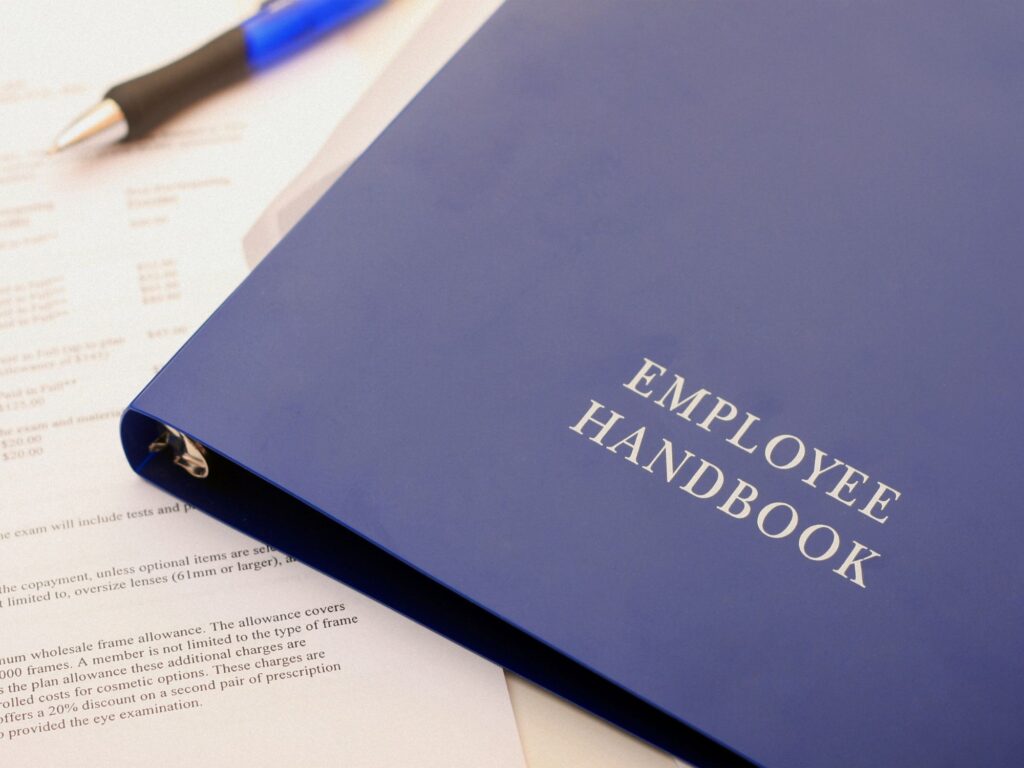
Congrats! You’ve passed the first few hurdles of starting a business. You have helped it grow enough to hire your first employees. It is challenging, yet exciting to have employees. You must now learn how to delegate to have a healthy work environment. It’s important to set a baseline. You will want your employees to understand the culture of your business. To execute this efficiently to your new staff, you must learn how to create an employee handbook.
Remember that new hires and long-term employees need to be familiar with your policies and procedures. No exception.
To achieve these things, you’ll need to make sure you’ve written a clear and formative employee handbook. This is an essential resource for your handmade businesses. As it clearly lays out exactly what you expect of your employees and exactly what they can expect of you. Let’s being..
What Is an Employee Handbook?

An employee handbook is a resource where your employee can find all your company’s policies and expectations. As well, as the mission and core values of your handmade business. Policies, processes, and benefits are all information you’ll want to include. Employee handbooks will keep your team aligned and accountable. It is the book of conduct and merit that plainly defines all the rules in one place. Learning how to create a employee handbook will lead everyone on your team towards success.
How Can an Employee Handbook Help Your Handmade Business?

Conducting an employee handbook will take some up-front effort. However, you will realize how seldom you are having to reexplain yourself once implementing the information below.
Clarify your business policies: It is vital to have clear policies in place to have a healthy work environment. As well as to let your employees understand what is and what is not okay to do. You’ll want to include the rules of conduct to establish ordinance and authority.
Establish clear work expectations: Setting goals is key. Keep your employees on track and measure their performance. Integrating staff expectations into your employee handbook will efficiently regulate your employees’ responsibilities.
Inform employees of their rights and benefits: Employees love to hear about what leverage they get in return for being a staff member of your business. Discussing your employees benefits with them is one of the first topics of interest that you can use to engage. Consider what benefits you are able to give to your employees. As well, as the rights they have to feel safe, motivated, and understood. Getting this part of your employee handbook “right” should be a top priority when configuring how to create an employee handbook for your small business.
Simplify on-boarding of new hires: Take 2-3 days to 1 week to onboard new employees. As a small business owner, it will be your responsibility to teach them everything they need to know about your handmade business. You must specify the tasks, introduce him/her to your team, and take the time to solve questions they might have. The employee handbook can make this task easier. Lay out your core rules, values, and regulations. This can also be something for your employees to reference. Especially, for when they have questions and you’re not around. This will eliminate blurred lines when issues arise.
Signal to employees that the same rules apply to everyone equally: This is extremely important. You must have a non-discriminative and equally opportunity work environment. This lays out that the same rules for everyone; regardless of authority level. This is something to take very seriously. These are the ethical rights your staff has. Not only should these be in place for morally good reasons, but legal purposes, as well. It would be wise to consider a legal advisor while conducting this portion of your employee handbook.
Prepare for challenging HR scenarios: Challenging situations will happen. For instance, disputes between co-workers. This isn’t something we want to happen as small business owners. You should have a protocol in place for the chance that issues occur. If you have 2 or more employees, this is something you need to be prepare for. What steps are you going to take if this happens? Outline this out for yourself and your employees. By doing this, you will know exactly how to handle the situation. For instance, this could be a point or strike system. Be clear that there are repercussions for wrong doings and layout probable reasons for termination.
Defend against potential lawsuits: This is for sexual harassment, discrimination, wrongful termination, and more. This goes hand-in-hand with the discriminative and equal opportunity work environment portion of your employee handbook. Again, it would be wise to consider hiring a legal advisor for this portion. Go above and beyond to make sure your employees feel safe. In addition to staff safety, be sure to cover your bases for your own safety should things go awry.
Having statements like these in place will yield the same recurring questions. Moreover, this document will be a go-to resource for questions about the policies in place.
What Should You Include in an Employee Handbook?

Here are some tips that will help you plan and write an employee handbook. This will give your business a professional edge and save time. Be to sure plan out exactly what information needs to be included to follow employee handbook requirements and regulations. You can start with…
A message that sets the tone for your business culture:
It’s nice to welcome your new employees as a first step. Set the tone for what they can expect from your company’s culture. Get them excited about being apart of your team. Some things you can consider are:
A welcome letter from you, the founder, or the company leaders.
Your history and mission statement.
Your company’s cultural values.
Introduce your industry.
Every company has to welcome new hires to the business. This should be the first thing of your employee handbook. Create warm and friendly welcome to the team. You will want to show him or her how excited you are to have them on your team.
Think through how you would like to talk to your new hires in person on day one. You would probably give them a quick rundown of your business and set expectations for their on-boarding. These things should be easily to find in your business plan.
HR expectations and policies:
When employees feel safe (physically, digitally, emotionally, etc.) they do their best work as a result. It is important to actually prove to them that they are in a safe environment being on your team. As the employer, you should address where your company stands on the hard to talk about. This includes topics and policies around harassment and diversity.
The employee handbook should clearly outline HR policies regarding things like:
Annual office closures and holidays.
Established working hours and lunch break policies.
Professional dress code expectations.
Notice required for vacation, time off, and medical leave.
Annual review policies and expectations.
How decisions about employee promotions and raises are made.
Procedures for filing workplace complaints.
Disciplinary procedures for when employees are not meeting expectations.
Make it clear to your employees who they should turn to should any issues arise. You want them to feel safe and comfortable knowing there is a protocol and procedure in place for them to turn to should something or someone ever make them feel uncomfortable.
Employee benefits:
Consider how to create an employee handbook for your small business, you should clearly identify the benefits employees have:
How much paid vacation time can they expect for every year of employment?
Do you have a parental or maternity leave policy?
What about your family and medical leave policies?
Do you allow for flexible work-from-home arrangements?
Do you provide opportunities for professional development?
Which health and dental benefits do you offer?
What about retirement benefits? Do you match employee contributions?
How do you evaluate how your team members are preforming?
Write out the benefits you plan to have prior to conducting interviews. Candidates are able to ask these questions during the beginning stages of recruitment. They need to be sure their own needs and values align with your business’s.
Written legal policies:
As your business grows, so does the risk of exposure to potential lawsuits. This can be anything from sexual harassment to wrongful termination, and more. Having a written policy around these topics can give you an added layer of legal protection, which you will 100% need as a leader of authority for your business.
Depending on where your business is, you may even be legally responsible to have written policies in place. It’s important to check your state rules and regulations for your employees and you, as a business owner.
Legal policies you may consider including in the employee handbook include:
Harassment and discrimination policies.
Nondisclosure agreements.
Noncompete agreements.
Rules about intellectual property rights.
Arbitration dispute procedures.
Privacy policies.
Safety procedures and expectations.
At-will employment policies.
Codes of conduct.
Understand that you must get these policies right the first time. There will not be a second time if you don’t. Check with your lawyer to make sure you cover all your bases and comply with any employee handbook legal requirements in your jurisdiction. You need to inform yourself and be aware of everything that can happen. Always protect yourself, your employees, and your business.
Tips to Building a Great Employee Handbook

Building your small business employee handbook can be time-consuming and daunting, especially if you’re starting from scratch. So, the big question is how you can build a great employee handbook?
Presentation is Key
Employee handbooks are dense and full of information. This can make your employees become bored or lost in it. A great way to avoid this, is by adding multimedia like infographics. For instance, this media could be in videos, how-to’s, etc. This will help ensure your team actually will actually read your handbook.
Keep it Simple
The last thing you want is for your employee handbook to contain legal jargon that is hard to read and understand. Instead, try to explain everything simplistic so it can be easily digestible.
This way, your employees won’t have confusion about what is in need of them. Lessen the possibility of failure by applying the employee rules you have in place. When you employees align with your expectations, you can clearly communicate all the important need-to-knows.
Keep Everything in an Accessible Location
If you send the employee handbook over an email, or you hand it out physically, there are high chances are that your new employees will not read your handbook, or possibly even lose it. With this being said, it is wise to have in on an easy-to-access spot for your handbook. Therefore, it’s important your team can even reference the content in real-time whenever they have a question about how your company does something. Above all, your employees are more likely to read your employee handbook more than just once.
Once you’ve outlined and written the first draft of your employee handbook, have an employment lawyer review it. This can help you if you have omissions or if something is not clear. Next, have an editor review it and make any necessary adjustments to it. Acquiring an editor will help improve the language of your employee handbook and make it clear and simple to read and understand. The very step to take, is to hand it over to a fresh pair of eyes to proofread. See if something needs edits, or if your employee handbook is now good to go!
Distributing Your Employee Handbook

After your handbook is published, ask your employees to read it carefully. Have your new employees sign a legal form stating that they have read, understood, and agreed to the terms, conditions and policies in place. Therefore, complete this task before their first day of employment with your business. Under no condition should you new employees being any form of work for you until these documents have been read and signed.
As as result of reading this article, you now understand how to create an employee handbook. You know there are plenty of ways to approach this part of your small business journey. Be sure to always begin with the foundation and values of your company. If you are able to, we always highly recommend consulting an employment lawyer for the final word on everything in your new employee handbook. After your employee handbook is reviewed and approved by a legal consultant, you are ready to hire your first employee. Way to go!
To learn more about how to conduct a business plan for your handmade business? Or do you need to learn more about the psychology aspects of small businesses? Subscribe to the Inventora newsletter below. You will receive educational hot takes and obtain exclusive documents to help your handmade business get off the ground.
The success of your small business first starts within. Organize your business with Inventora today! Try Inventora’s free inventory system to start streamlining and automating your handmade business.
Need a more advanced inventory system with unlimited features? Sign up for Inventora’s business plan here!
For more answers to your questions about how to create an employee handbook, ask us in the comments, or email us at hello@inventora.com.


